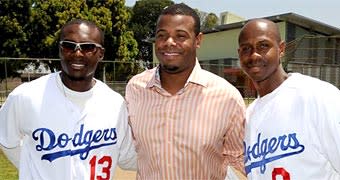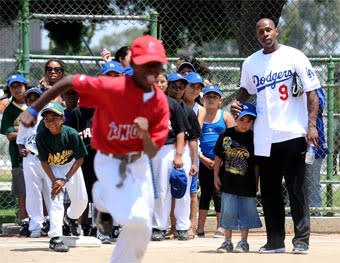Stars help give baseball a pulse in inner cities

Orlando Hudson (at left), Ken Griffey Jr. and Juan Pierre.
(Jon Soohoo)
LOS ANGELES – A baseball rolled through a dirt infield into center field.
A little boy flung his tiny aluminum bat and took off.
Two others chased the ball into center field.
Parents, dozens of them, yelled encouragement, and coaches official and unofficial waved that little boy past first base and then around third and toward home.
Dust swirled at home plate when the little boy arrived, and the umpire shouted, “Safe!” and the people cheered as though Manny Ramirez(notes) himself had hit this home run.
Covered in half the infield and some of the third-base line, the boy stood and didn't bother to dust himself off, but turned and found his parents in the stands.
It looked like baseball, sounded like baseball, felt like baseball.
Only, we'd been told it doesn't exist here, a few blocks from Crenshaw Boulevard in South Central, in places like it, in inner cities where basketball is king, baseball is tedious and hope is scarce.
So what is 10-year-old Brandon doing here? What is 10-year-old Kalonni doing with that baseball glove on his hand? That Los Angeles Dodgers cap perched on his head?
What's all that screaming and clapping, and laughter and disappointment? Why has the shortstop thrown his cap to the ground, kicked it to the pitcher's mound?
And why is Orlando Hudson(notes) here, along with Ken Griffey Jr.(notes) and Juan Pierre(notes)?
Because Tommy Stokes insists on it, that's why.
At the Van Ness Recreation Center at 2nd and Slauson avenues, there are three diamonds – four if you count “the mud bowl,” where the rains come and turn an entire corner of the park into a swamp for weeks – and 29 baseball teams and nine softball teams.
This season, 48 three- and four-year-olds were signed up.
“You're laughing,” Stokes says. “I'm serious.”
Stokes is senior recreation director at VNRC, has been for years. Asked why there is baseball here amid all the other options, few of them good, Stokes says, “I live here.”
His boss, Bara King, says you need to know where to look.
“It's here in pockets,” she said of a game that is fighting to regain its standing in urban neighborhoods such as these, particularly with African-American youths. “There are areas such as this. It depends on the staff.”
It is championship Saturday, and it's hot. Dozens of boys and girls, most of them no older than 11 or 12, have broken into three groups: red bracelets with Hudson, blue with Pierre, green with Griffey.
“Saddle up, blues!” Pierre yells and leads them to home plate, where on their way to first – “Touch the base!” he shouts – most will run out from under their new blue ball caps.
Pierre pauses for a second. “Man,” he says, “I couldn't imagine a big leaguer coming out to my Little League field.”

Players at the Van Ness Recreation Center.
(Jon Soohoo)
Hudson gathers his reds, puts his forearms on a couple young heads, and talks for 20 minutes. He gets their names and their favorite subjects, and asks them about doing homework, and about the gangs. The kids get quiet and nod their heads.
“You ain't got to go with them,” Hudson tells them. “Let them do what they do. You're going to see others skipping out. But not you. You're going to stick with it. You're going to make the best of what you have.”
In the back, an 11-year-old wearing a purple Lakers jersey sighs.
“Just sign some autographs,” he mutters.
Among the greens, a hand raises in the back. Griffey points.
“Have you ever struck out?” a small voice asks.
Griffey smiles. “Yeah,” he replies.
“I don't strike out,” the voice says.
And Griffey bursts into laughter.
Another hand.
“Can you moonwalk?”
“No,” Griffey says. “I can't moonwalk. But, hey, I got one for you all. Kobe or LeBron?”
And 20 kids start hollering all at once. It's Kobe's town.
Hudson is here as part of his “Around the Mound” tour, where he spends afternoons just like this in cities including New York (with Gary Sheffield(notes)), Atlanta (with Garret Anderson(notes)), Cincinnati (with Brandon Phillips(notes)) and Milwaukee (with Prince Fielder(notes)). Pierre, who hosts inner-city kids at a handful of games every season, comes along to some of them.
Forty-five years ago, John Young played his high school junior varsity football games on these fields, lugging his gear from his house on W. 103rd Street and Towne Avenue. Coco Crisp(notes) played here. Darryl Strawberry and Eric Davis grew up not far from here. Young is the founder of RBI (Reviving Baseball in Inner cities) and so for two decades has stood out in front of boys and girls, spreading the gospel of the game. His program aids and operates out of 18 recreation centers like this one in L.A.
Young is done introducing the three major league players when a teen-aged boy approaches, sticks out his hand and says, “I never got to thank you for inviting me to Loney's Lounge,” a program in which Dodgers first baseman James Loney(notes) hosts local kids at Dodger Stadium.
“You're welcome, son,” Young says.
He turns back and says, “It's about participation.”
Stokes says he draws boys and girls from nine zip codes.
“Even from the 90009,” he says, meaning downtown, the area around city hall. “All these kids, their parents played here. Their kids will, too.”
Stokes has seen the kids come and go, the professional athletes come through, the seasons a certain singer-songwriter sponsored a team called, “Barry White's Maestro Players,” the days like today, with all this excitement, when every one of them will put a baseball under their pillow tonight.
“We do everything professionally and everything starts on time,” Stokes says. “There's no such thing as late.”
And so on championship Saturday at Van Ness park the major leaguers climb into their black SUVs. Tommy Stokes has a game to start. It's time to play ball.
“This is it, man,” Pierre says on his way out. “This is what it's all about. Me and O, we've been in the same situation they are, playing in leagues just like this. These kids are excited about playing baseball.”
Ten-year-old Kalonni pulls down his cap, heads toward the dugout. He plays second base. Ten-year-old Brandon heads toward home. He's not playing.
“Naw,” he says. “I play basketball.”
